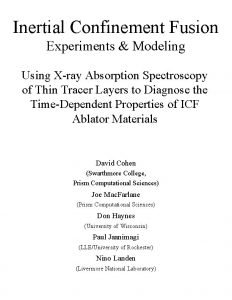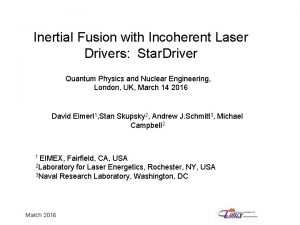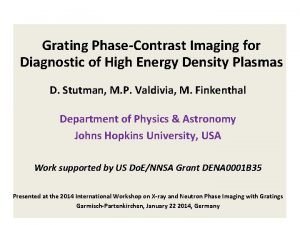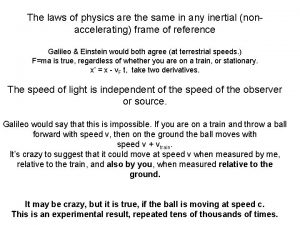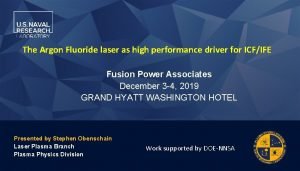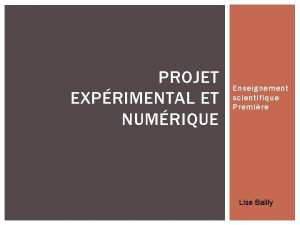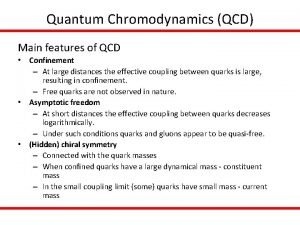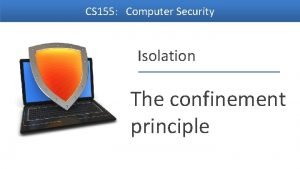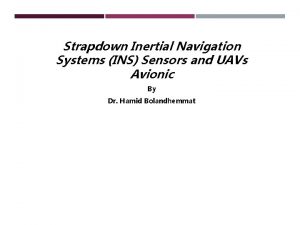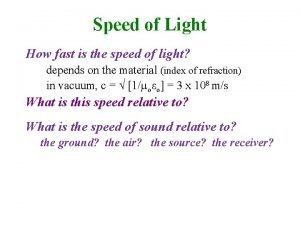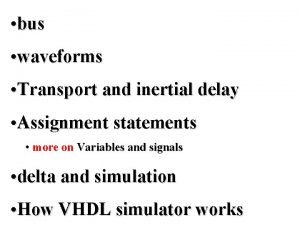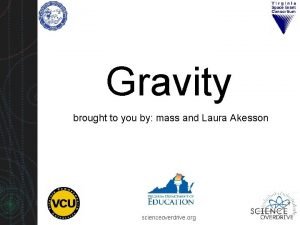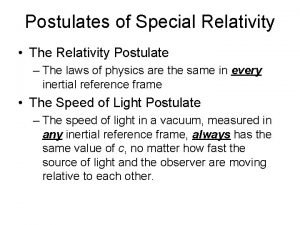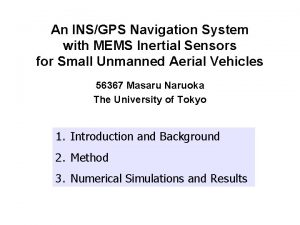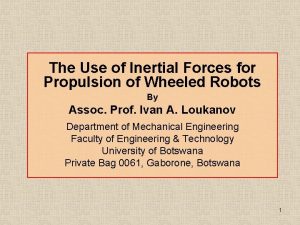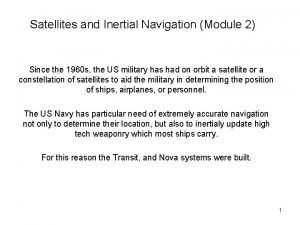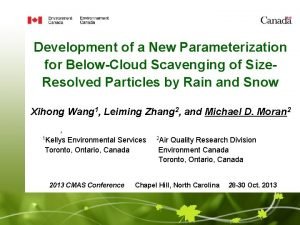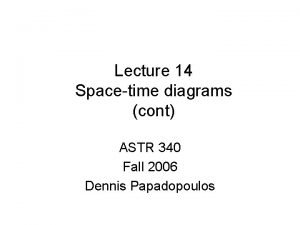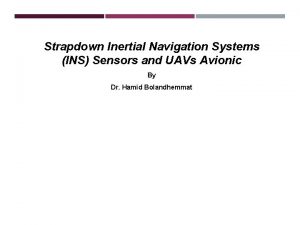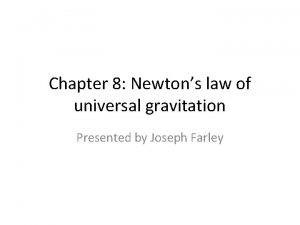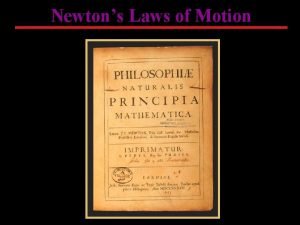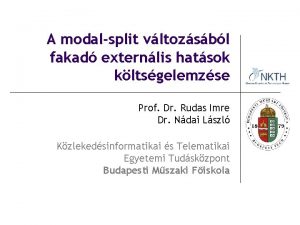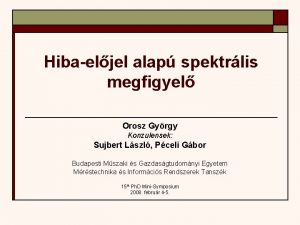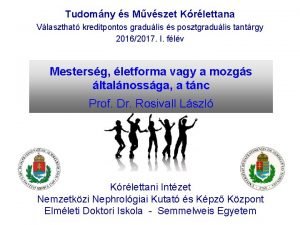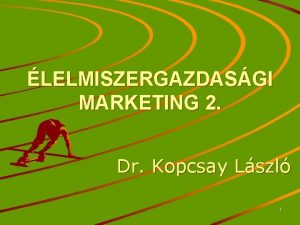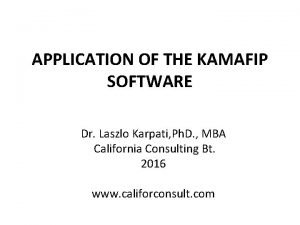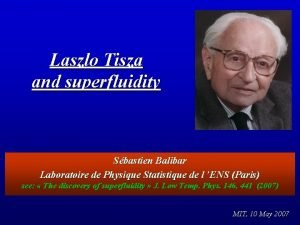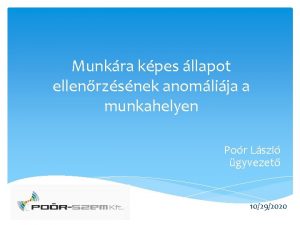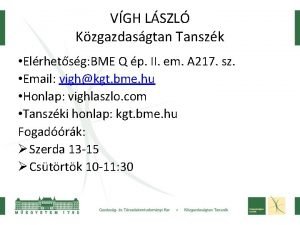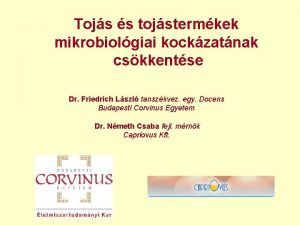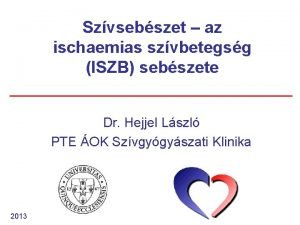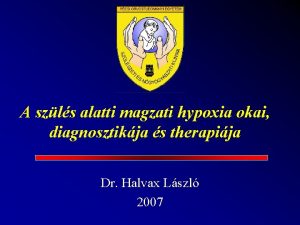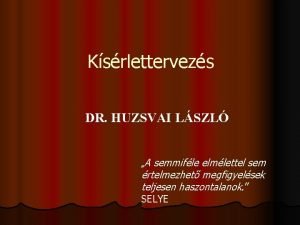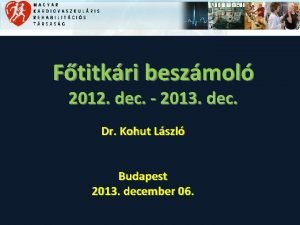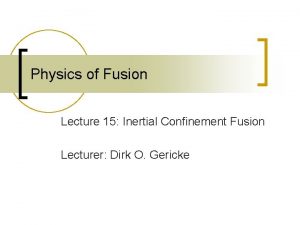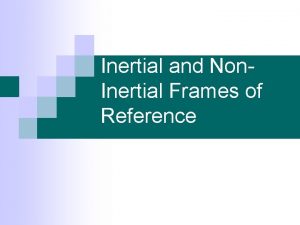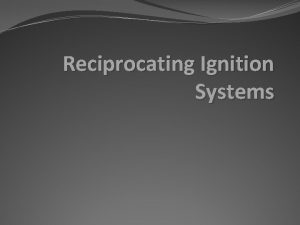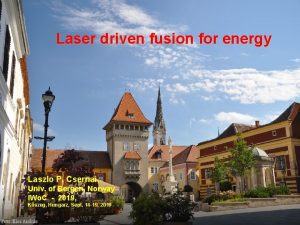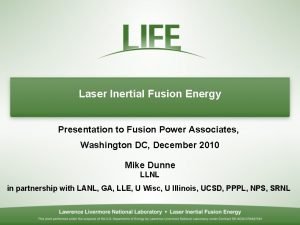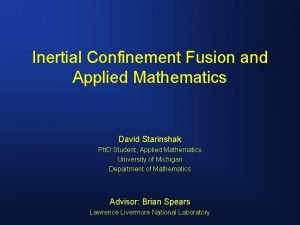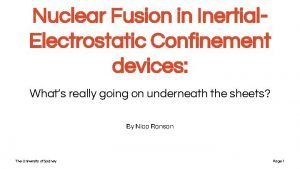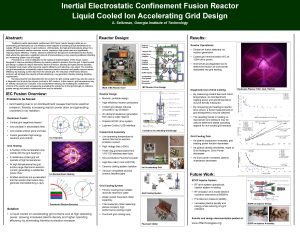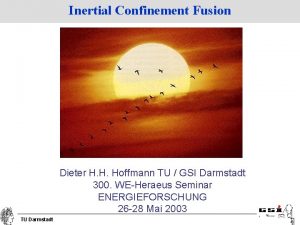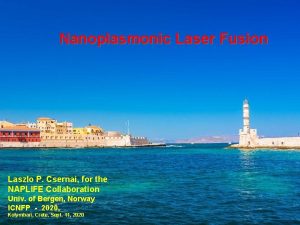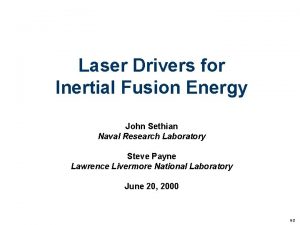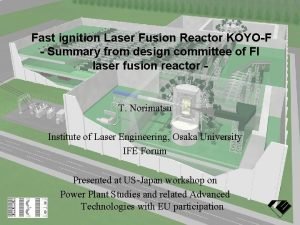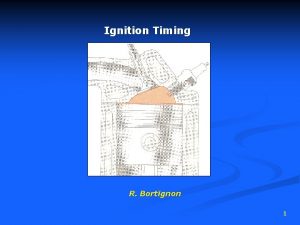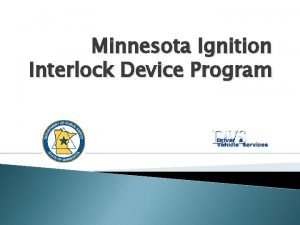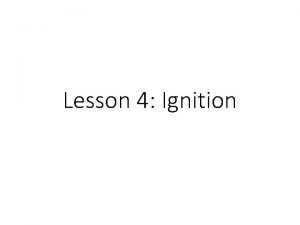Laser driven ignition for inertial confinement fusion Laszlo




![[Clark et al. , Phys. Plasmas, 22, 022703 (2015). ] Snapshots of 3 D [Clark et al. , Phys. Plasmas, 22, 022703 (2015). ] Snapshots of 3 D](https://slidetodoc.com/presentation_image_h/041b2d65e0ae1a99de2c2a01c06787a1/image-5.jpg)





![[ A. H. Taub (1948) ] Taub assumed that (physically) only slow space-like shocks [ A. H. Taub (1948) ] Taub assumed that (physically) only slow space-like shocks](https://slidetodoc.com/presentation_image_h/041b2d65e0ae1a99de2c2a01c06787a1/image-11.jpg)



![[ R. Chatterjee, et al. , Phys. Rev. Lett. 96, 202302 (2006) ] 15 [ R. Chatterjee, et al. , Phys. Rev. Lett. 96, 202302 (2006) ] 15](https://slidetodoc.com/presentation_image_h/041b2d65e0ae1a99de2c2a01c06787a1/image-15.jpg)

![[ E. Frodemann, et al. , J. Phys. G 34, 2249 -2254 (2007) ] [ E. Frodemann, et al. , J. Phys. G 34, 2249 -2254 (2007) ]](https://slidetodoc.com/presentation_image_h/041b2d65e0ae1a99de2c2a01c06787a1/image-17.jpg)

![[ Stefan Floerchinger, and Urs Achim Wiedemann, Phys. Rev. C 89, 034914 (2014) ] [ Stefan Floerchinger, and Urs Achim Wiedemann, Phys. Rev. C 89, 034914 (2014) ]](https://slidetodoc.com/presentation_image_h/041b2d65e0ae1a99de2c2a01c06787a1/image-19.jpg)





![[ Martin Greve, IFT Seminar, Fall (2017) for PV Solar panels] Omnidirectional TV antenna [ Martin Greve, IFT Seminar, Fall (2017) for PV Solar panels] Omnidirectional TV antenna](https://slidetodoc.com/presentation_image_h/041b2d65e0ae1a99de2c2a01c06787a1/image-25.jpg)






















- Slides: 47

Laser driven ignition for inertial confinement fusion Laszlo P. Csernai, Univ. of Bergen, Norway Wuhan University of Technology, China Seminar - University of Szeged, May 3, 2019 1

LPB, 36(2), (2018) 171 -178. … and 35 th Hirschegg Int. Workshop on High Energy Density Physics, Jan. 25‐ 30, 2015 2

Indirectly Driven, ICF target for NIF at LLNL 3

Indirectly Driven, ICF target for NIF Time profile of the laser beam: Initial precompression of ~ 10 ns, Stable compression Then final “shocks” of ~ 15 ns to ignite [O. A. Hurricane et al. , Nature, 506, 343 (2014), doi: 10. 1038/nature 13008 ] 4
![Clark et al Phys Plasmas 22 022703 2015 Snapshots of 3 D [Clark et al. , Phys. Plasmas, 22, 022703 (2015). ] Snapshots of 3 D](https://slidetodoc.com/presentation_image_h/041b2d65e0ae1a99de2c2a01c06787a1/image-5.jpg)
[Clark et al. , Phys. Plasmas, 22, 022703 (2015). ] Snapshots of 3 D simulation 22. 53 ns: peak impl. Velocity 23. 83 ns: bang, max compr. 22. 96 ns: jet out, up left Green surface: Ablator/DT-f. Peaks: Ablator defects Colours: Left: fluid speed Right: matter density 80 μm 5

Phys. Rev. Lett. 120, 245003 – 14 June 2018: = Q’ > 2 6

S. Le Pape et al. , (LLNL - NIF) Depleted Uranium Notice: The last energetic part of the pulse is less than 4 ns! (It was ~ 15 ns earlier. ) published 14 June 2018 7

Notice: The ignition peak is now in the centre of the compressed target pellet! 80 μm - 2018 8

Approximate energy efficiency of diff. process steps of NIF: 2. 1 MJ Energy out 14 k. J 2014: = 0. 003318% ! 2018: = fusion energy of 54 k. J.

Burning of Quark Gluon Plasma in Relativistic, Radiation Dominated Systems according to Relativistic Fluid Dynamics Applications to Pellet Fusion Classical Fluid Dynamics (CFD) does assumes that all dynamical processes, including shocks and detonations, are having speeds slower than the speed of light, c. Initial Relativistic FD (RFD) maintained this assumption based on the requirement of causality [A. Taub, 1948]. Engineering books keep this assumption even today! Relativistic Heavy Ion Physics proved the opposite! 10
![A H Taub 1948 Taub assumed that physically only slow spacelike shocks [ A. H. Taub (1948) ] Taub assumed that (physically) only slow space-like shocks](https://slidetodoc.com/presentation_image_h/041b2d65e0ae1a99de2c2a01c06787a1/image-11.jpg)
[ A. H. Taub (1948) ] Taub assumed that (physically) only slow space-like shocks or discontinuities may occur (with space-like normal, λ 4=0). This was then taken as standard, since then (e. g. LL 1954 -) 11

[ L. P. Csernai, Zh. Eksp. Teor. Fiz. 92, 379 -386 (1987) & Sov. Phys. JETP 65, 216 -220 (1987) ] +1 -1 corrected the work of [ A. Taub, Phys. Rev. 74, 328 (1948) ] λα λα = ± 1 12

[ L. P. Csernai: Introduction to Relativistic Heavy Ion Collisions, (1994, John Wiley & Sons, Cichester, England) ] 13

Discovery of QGP: 2000 CERN 2001 BNL [U. W. Heinz and P. F. Kolb, Phys. Lett. B 542, 216 (2002)] 14
![R Chatterjee et al Phys Rev Lett 96 202302 2006 15 [ R. Chatterjee, et al. , Phys. Rev. Lett. 96, 202302 (2006) ] 15](https://slidetodoc.com/presentation_image_h/041b2d65e0ae1a99de2c2a01c06787a1/image-15.jpg)
[ R. Chatterjee, et al. , Phys. Rev. Lett. 96, 202302 (2006) ] 15

Light cone [ E. Molnar, et al. , J. Phys. G 34 (2007) 1901 ] 16
![E Frodemann et al J Phys G 34 2249 2254 2007 [ E. Frodemann, et al. , J. Phys. G 34, 2249 -2254 (2007) ]](https://slidetodoc.com/presentation_image_h/041b2d65e0ae1a99de2c2a01c06787a1/image-17.jpg)
[ E. Frodemann, et al. , J. Phys. G 34, 2249 -2254 (2007) ] 17

18
![Stefan Floerchinger and Urs Achim Wiedemann Phys Rev C 89 034914 2014 [ Stefan Floerchinger, and Urs Achim Wiedemann, Phys. Rev. C 89, 034914 (2014) ]](https://slidetodoc.com/presentation_image_h/041b2d65e0ae1a99de2c2a01c06787a1/image-19.jpg)
[ Stefan Floerchinger, and Urs Achim Wiedemann, Phys. Rev. C 89, 034914 (2014) ] Light cone 19

Light cone Size and time extent of hadronization is measured by two particle correlations, via Hanbury-Brown & Twiss effect. [ N. Armesto, et al. , Nucl. Phys. A 931 (2014) 1163 ] 20

Applications to Pellet Fusion Relativistic Heavy Ion Physics proves that simultaneous ignition and burning is possible, both theoretically and experimentally! Up to now all theoretical studies of Internal Confinement fusion are based on Classical Fluid Dynamics (CFD) [HYDRA, LASNEX] Still the aim is to • achieve Volume Ignition • achieve Rapid Ignition • but within CFD ? ! 21

Fusion reaction: D + T n(14. 1 Me. V) + 4 He (3. 5 Me. V) Constant absorptivity, Spherical irradiation Ignition temperature = T 1 Simultaneous, volume ignition up to 0. 5 R (i. e. 12% of the volume). Not too good, but better than: [ L. P. Csernai & D. D. Strottman, Laser and Particle Beams 33, 279 (2015). ] 22

Can we achieve better volume ignition, and how? Two ideas are combined by L. P. Csernai, N. Kroo, I. Papp [ Patent # P 1700278/3 ](*) • Heat the system uniformly by radiation with RFD • Achieve uniform heating by Nano-Technology Mechanical compression and adiabatic heating should be reduced, because it is slow and leads to Rayleigh-Taylor instabilities. Similarly outside ablator surface should be reduced also. Uniform, 4π radiation should heat the target to ignition within the light penetration time (i. e. ~ 10 -20 ps). This follows from RFD! [ L. P. Csernai, N. Kroo, I. Papp, Laser and Particle Beams, LPB, 36(2), (2018) 171 -178. . https: //doi. org/10. 1017/S 0263034618000149 ] 23

Golden Nano-Shells – Resonant Light Absorption 24
![Martin Greve IFT Seminar Fall 2017 for PV Solar panels Omnidirectional TV antenna [ Martin Greve, IFT Seminar, Fall (2017) for PV Solar panels] Omnidirectional TV antenna](https://slidetodoc.com/presentation_image_h/041b2d65e0ae1a99de2c2a01c06787a1/image-25.jpg)
[ Martin Greve, IFT Seminar, Fall (2017) for PV Solar panels] Omnidirectional TV antenna 25

LPB, 36(2), (2018) 171 -178. Variation of absorptivity by Nanotechnology Doping INF pellets with golden nano-shells enables us to achieve the desired variable absorptivity (Tanabe, 2016). 26

T (Me. V) The absorption coefficient is linearly changing with the radius: In the center, r = 0, αK = 30 cm-1 while at the outside edge αK = 8 cm-1. The temperature is measured in units of T 1 = 272 ke. V, and Tn = n T 1. Simultaneous, volume ignition is up to 0. 9 R, so 73% of the fuel target! 27

Problem: Not easy to realize, 4π irradiation geometry 80 -192 laser beams In the earlier estimates we did establish that: - The principle of simultaneous volume ignition is theoretically possible with nano-shells - We did not estimate the necessary laser energy need, and assuming extremely large laser input energy we neglected the losses. • However the basic principle, the simultaneous all volume ignition can be achieved in 3 D, 2 D and 1 D geometry also !!! (Einstein’s synchronization of watches. ) • We did calculate the realistic energy balance • So, we repeated realistic estimates in 1 D with a flat (coin like) target. 28

Thick Coin like target - New Developments L. P. Csernai, N. Kroo, I. Papp X Thickness of the target is: h h depends on pulse energy, ignition energy, target mass, … 29

Without nano antennas The deposited energy from laser irradiation from one side only. The absorption is constant, this leads to an exponentially decreasing energy deposition, and only a negligibly small energy reaches the opposite end of the target. 30

Without nano antennas Irradiation from both sides. Exponential decrease of deposited energy. Due to the already deposited energy, less energy reaches the middle The front and back surface is heated up but the middle is not! Pulse length is: t. P = h/c 31

With nano antennas The absorptivity is increased towards the center, due to the implanted nano antennas. The deposited energy from laser irradiation from one side only. The absorption is modified by nano antennas so that the absorptivity is increasing towards the middle, so that the deposited energy is constant up to the middle. Then the absorptivity is decreasing, but hardly any energy is left in the irradiation front. Thus again only a negligibly small energy reaches the opposite end of the target. 32

With nano antennas Irradiation from both sides. Ignition energy is: Qi /m e. g. for DT target: Qi /m = 27 k. J/g if we have Q = 100 J , then we can have a target mass: m. DT = Q / Qi g = 3. 703 mg. Then with m. DT and ρDT given we get the DT-target’s volume, VDT and h. DT = 2. 67 mm. 33

With nano antennas Ignition is reached at contour line Q = 1. 34

Test of principles with smaller pulse energy 1 Relativistic time-like (simultaneous) ignition 2 Using nano antennas to reach whole volume uniform ignition or transition 3 Using 1 D geometry, with two beams from opposite direction for realizability Let us take a P = 30 m. J , 1 ps laser, a polilactic acid (PLA) target with T = 150 C melting temperature, Qi /m = 28 J/g this leads to mi = 0. 32 mg target mass, and hi = 683 μm target thickness. The melting transition profile can be checked by simple and affordable analysis by microscope. The distribution, and absorption properties of implanted nano antennas can be well optimized. 35

European Laser Infrastructure – Szeged, HU ELI-ALPS Szeged: EU Extr. Light Infrastructure Attosec. Light Pulse Source 2 PW High Field laser 10 Hz, <10 fs, 20 J 36

HAS Wigner RCP, Budapest Gagik P. Dzsotjan, József Bakos, Gábor Demeter, Dávid Dzsotjan, Miklós Kedves, Béla Ráczkevi, Zsuzsanna Sörlei, Péter Lévai Ti-Si Hidra L. 30 m. J 10 Hz 40 fs Laser wake acceleration of protons for radiation therapy - proton beam energy is deposited at a location of a certain depth [Bragg peak] - tumor treatment with minimal side damage (compared to other radiation therapies) - target is low density (~ like water or more) - Collaboration with Peking University, China These features are similar to the needs of laser induced ICF with nano-plasmonics! Deposition at a depth via the Bragg peak is an alternative way to get volume ignition Gábor Veres, István B. Földes, Márk Aladi, Imre Ferenc Barna, Róbert Bolla, Zsolt Kovács, Mihály Pocsai, Dániel Dunai, Gábor Anda et al. Fusion plasma diagnostics, ITER, JET etc. Péter Dombi, Péter Rácz, Norbert Kroo et al. Laser induced nano-plasmonics 37

HAS Centre for Energy Research, Budapest Inst. for Technical Physics and Materials Science András Deák, S. Pothorsky, D. Zámbó, D. Szekrényes, Z. Hajnal, Béla Pácz et al. Nano-particle assembly at the single particle level - manufacturing of Au nano-shells and nano-rods - imbedded in different concentrations in carriers - polarized target constructions with nano-rods (for polarized laser irradiation) - testing resonant light absorption 38 [Detecting patchy nanoparticle assembly at the single-particle level, S. Pothorszky et al. , Nanoscale 9(2017)10344]

Nano-particle absorption The target absorptivity is increased via core-shell type plasmonic nano-shells. Calculations via solving the Maxwell equations, and evaluating the ohmic heating were performed. 1 ps laser pulse length, λ = 800 nm, One-sided & two-sided irradiation tested, 85 -100 % absorption in the target length h. Nano-antenna shapes, layer configurations, layer distribution varied & analyzed. [M. Csete, et al. , University of Szeged, HU] 39

40

Available resources: Pulse energy frequency length LLNL NIF 192 laser 3 D (1 laser: 11. 2 k. J 1/day ~ 10 -30 ns ELI-APLS 2 PW High field laser 20 J 10 Hz < 10 fs (34 J) BELLA, L. Berkeley Nat. Lab. 34 J 1 Hz < 30 fs GSI/FAIR PHELIX laser > 0. 5 ps 200 J 1/90 min Wigner - Coherent Ti-Si Hidra L. 30 m. J 10 Hz 40 fs (upto 100 m. J) Optimal for laser induced ICF with nano-plasmonics tests ~ 100 J 1 Hz 1 -10 ps ! 41

Experimental test of similar configuration @ Shen. Guang-II Up, Shanghai : 4 (up) + 4(down) lasers Target thickness, h (3. 6μm-1 mm) & radius, R, (150 -400μm) were varied. Total pulse energy 1. 2 k. J (2 ns) for 8 beams. Shortest (250 ps) pulses -> 100 s Me. V ions > non-thermal distr. = directed ion acceleration Typical fusion neutron energies were measured & used to extract the target density. 42

Experimental test of similar configuration @ Shen. Guang-II Up, Shanghai : 43

Thus, ultra-relativistic heavy ion physics lead to discovery Quark Gluon Plasma (QGP), but also to advances in (i) relativistic fluid dynamics (RFD). With (ii) nano technology this may revolutionize in a simple, and (iii) affordable 1 D geometry the technological development of ( iv) Inertial Confinement Fusion. This methodology may be used to study other dynamical, radiation dominated processes. * 44

45

49

50
 Inertia xray
Inertia xray Inertial confinement
Inertial confinement Inertial confinement
Inertial confinement Inertial and non inertial frame of reference
Inertial and non inertial frame of reference Inertial and non inertial frame of reference
Inertial and non inertial frame of reference Argon fluoride laser
Argon fluoride laser Projet enseignement scientifique 1ère
Projet enseignement scientifique 1ère Confinement qcd
Confinement qcd Confinement principle in computer system security
Confinement principle in computer system security York will end longterm solitary jails
York will end longterm solitary jails Solitary confinement effects
Solitary confinement effects Strapdown inertial navigation system
Strapdown inertial navigation system Speed of light in vacuum
Speed of light in vacuum Difference between signal and variable in vhdl
Difference between signal and variable in vhdl Wearable inertial sensors
Wearable inertial sensors Inertial impaction
Inertial impaction Gravitational mass vs inertial mass
Gravitational mass vs inertial mass The law of relativity
The law of relativity Mems inertial navigation system
Mems inertial navigation system Inertial propulsion drive
Inertial propulsion drive Inertial guidance module
Inertial guidance module Inertial impaction
Inertial impaction Twin paradox
Twin paradox Inertial impaction
Inertial impaction Sagnac effect
Sagnac effect Fly wheel definition
Fly wheel definition Inertial mass vs gravitational mass
Inertial mass vs gravitational mass Miniature inertial measurement unit
Miniature inertial measurement unit Inertial mass vs gravitational mass
Inertial mass vs gravitational mass Prof. dr. rudas lászló
Prof. dr. rudas lászló Sujbert lászló
Sujbert lászló Nagy lászló menyegző elemzés
Nagy lászló menyegző elemzés Kopcsay lászló
Kopcsay lászló Laszlo karpati
Laszlo karpati Laszlo tisza
Laszlo tisza Dr totth lászló fül orr gégész kaposvár
Dr totth lászló fül orr gégész kaposvár Dr poór lászló
Dr poór lászló Mrts
Mrts Laszlo systems
Laszlo systems Jeno laszlo vargha
Jeno laszlo vargha Tojs
Tojs Dr hejjel lászló
Dr hejjel lászló Nav czinege attila
Nav czinege attila Orehóczki lászló
Orehóczki lászló Dr balla lászló
Dr balla lászló Koponyavégű fekvés
Koponyavégű fekvés Huzsvai lászló statisztika
Huzsvai lászló statisztika Dr kohut lászló vélemények
Dr kohut lászló vélemények
